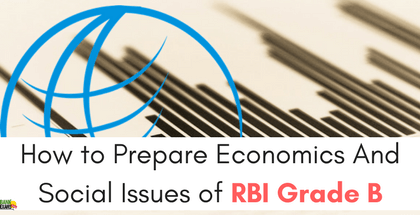The Economic and Social Issues is a critical part of the RBI Grade B Phase II Examination. It tests an applicant’s skills about the Economic as well as Social concepts (static skills) and the numerous issues regarding National and International Economic as well as Social issues (current affairs). It’s an objective paper which carries 100 marks for the duration of 90 minutes.
In this article, we have mentioned the syllabus, resources, and guideline to appear the Economic and Social issues part of your preparation:
Given below is the syllabus of Economics and Social Issues:
While the static part specializes in conceptual understanding of economic & social concepts, the dynamic segment specializes in current affairs associated with economic and social issues.
In this article, we have mentioned the syllabus, resources, and guideline to appear the Economic and Social issues part of your preparation:
Given below is the syllabus of Economics and Social Issues:
Syllabus of Economics
Growth and development
- Size of growth: National income as well as per capita income
- Poverty alleviation as well as employment generation in India
- Sustainable Development as well as Environmental issues
Globalization
- Commencing up of the Indian Economy
- Balance of Payments
- Import- Export policy
- International Economic Institutions
- World Bank and IMF
- WTO
- Regional Economic Co-operation
Economic reforms in India
- Monetary and Fiscal policy
- Industrial and Labor policy
- Role of Economic Planning
- Privatization
Social System in India
- Multiculturalism
- Demographic Tendencies
- Urbanization and Migration
- Gender Issues
- Social Justice: Positive Discrimination in desires of the underprivileged
- Social Action
- Indian Political system
- Human development
- Social sectors in India: Health & Education
Resources for preparation
Following are the questions can be asked in Economics and Social Issues subjects:- Economic Survey of India
- The Budget Document
- Conceptual based (Books)
- Basic skills (NCERT)
- Newspapers (Current events, factual in nature)
- Press Information Bureau
- The Hindu Newspaper
- The Economic Survey of India
- The Union Budget
- Economic & Political Weekly
- Yojana
- Pratiyogita Darpan
- Southern Economist
- Business India
- RBI Bulletins
Strategy
- Check the sample papers to be familiarise with the type of questions
- Determine your pace & accuracy
- Perceive your strengths & weaknesses
Approach
The Economic and Social Issues preparation will be divided into two parts Static and DynamicWhile the static part specializes in conceptual understanding of economic & social concepts, the dynamic segment specializes in current affairs associated with economic and social issues.
Static
- If you’re new to economics, refer to NCERT economics textbooks of class 10, eleven and 12 . Get ya clear vision of the topics like national income, improvement and boom, budget, financial institution quotes, fiscal/revenue deficits, banking & finance sector of India, Niti Aayog, planning fee, position of government of India, taxation, inflation, repo charge etc .
- After reading the basic concepts move to monetary plicy of India, modern census, union budget, FAQ section of the RBI website
Dynamic
- Magazines like Yojana and Pratiyogita Darpan and newspapers like The Hindu and monetary instances for current affairs of remaining are a good source for dyanmic concepts of economics. Pay attention to the minute information like facts, figures, numbers, and percentages noted. Numerous questions requested on this segment are factual in nature.
- For social, read up approximately the diverse social zone schemes & welfare packages.



